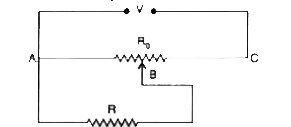What is the de Broglie wavelength associated with (a) an electron moving with a speed of 5.4×106m/s, and (b) a ball of mass 150 g travelling at 30.0m/s?Solution in Kannada
(b) For the ball:
Mass m.=0.150 kg, speed v.=30.0m/s
Then momentum p.=m.v.
=0.150(kg)×30.0(m/s)
p.=4.50kgm/s
de-Brogile wave length λ.=h/p..
=6.63×10−34Js4.92×10−24kgm/s
λ.=1.47×10−34m
The de-Brodgile wavelength of electron is comparable with X-ray wave lengths. However for the balls it is about 10−19 times the size of the proton , quite beyond experimental measurement.
Topper's Solved these Questions
- DUAL NATURE OF RADIATION AND MATTERBOOK - OSWAAL PUBLICATIONCHAPTER - DUAL NATURE OF RADIATION AND MATTEREXERCISE - TOPIC-2 DE-BROGLIE RELATION (LONG ANSWER TYPE QUESTIONS)
1 Videos
- CURRENT ELECTRICITY BOOK - OSWAAL PUBLICATIONCHAPTER - CURRENT ELECTRICITY EXERCISE - TOPIC-3 (POTENTIOMETER & APPLICATIONS) (NUMERICAL PROBLEMS)
2 Videos
- ELECTRIC CHARGES & FIELDSBOOK - OSWAAL PUBLICATIONCHAPTER - ELECTRIC CHARGES & FIELDSEXERCISE - (TOPIC -2)Numerical Problems
5 Videos
Similar Questions
What are matter waves? Derive an expression for the de Broglie wave length.
View SolutionA resistance of RΩ draws current from a potentiometer. The potentiometer has a total resistance R0Ω.A voltage V is supplied to the potentiometer. Derive an expression for the voltage across R when the sliding contact is in the middle of the potentiometer.

View SolutionAn atom was earlier assumed to be sphere of radius a having a positively charged point nucleus of charge +Ze at its centre . This nucleus was believed to be surrounded by a uniform desity of negative charge that made the atom neutral as a whole.
Use this theorem to find the electric field of this atom at a distance r(r>a) from the centre of the atom.
View SolutionWhat is the de-Broglie wavelength associated with (a) an electron moving with speed of 5.4×106ms−1, and (b) a ball of mass 150g travelling at 30.0ms−1? h=6.63×10−34Js, mass of electron =9.11×10−31kg.
View SolutionThe de Broglie wavelength associated with a ball of mass 150 g travelling at 30 m s^(-1) is
View Solution(a) एक इलैक्ट्रॉन जो 5.4×105m/s की चाल से गति कर रहा है,
(b) 150g द्रव्यमान की एक गेंद जो 30.0m/s की चाल से गति कर रही है, से जुड़ी दे ब्रॉग्ली तरंगदैर्घ्य क्या होगी?
View Solution100 ग्राम द्रव्यमान की एक गेंद 30 मी/से के वेग से चल रही हैं । इससे सम्बन्ध दी-ब्रोग्ली तरंगदैर्ध्य होगी -
View Solution150 g द्रव्यमान की एक गेंद, जो 30⋅0m/s की चाल से गति कर रही है, से जुड़ी दे ब्रॉग्ली तरंगदैर्ग्य क्या होगी ?
View Solution(a) एक इलेक्ट्रॉन जो 5.4×106m/s की चाल से गति कर रहा है, (b) 150 g द्रव्यमान की एक गेंद जो 30.0 m/s की चाल से गति कर रही है, से जुड़ी दे-ब्रॉग्ली तरंगदैर्ध्य क्या होगी?
View SolutionWhat is the de Broglie wavelength associated with (a) an electron moving with a speed of 5.4xx10^(6)m//s , and (b) a ball of mass 150 g travelling at 30.0 m/s ?
View SolutionWhat is the de Broglie wavelength associated with (a) an electron moving with a speed of 5.4×106m/s, and (b) a ball of mass 150 g travelling at 30.0m/s?
View SolutionWhat is the de Broglie wavelength associated with (a) an electron moving with a speed of 5.4×106m/s, and (b) a ball of mass 150 g travelling at 30.0m/s?
View SolutionWhat is the de Broglie wavelength associated with (a) an electron moving with a speed of 5.4×106m/s, and (b) a ball of mass 150 g travelling at 30.0m/s?
View SolutionWhat is the de Broglie wavelength associated with (a) an electron moving with a speed of 5.4xx10^(6) m//s , and (b) a ball of mass 150 g travelling at 30.0 m//s ?
View SolutionWhat is the de-Broglie wavelength associated with (a) an electron moving with speed of 5.4×106ms−1, and (b) a ball of mass 150g traveling at 30.0ms−1? h=6.63×10−34Js, mass of electron =9.11×10−31kg.
View SolutionWhat is the de-Broglie wavelength associated with (a) an electron moving with a speed of 5.4×106ms−1 and (b) A ball of mass 150 g travelling at 30.0ms−1?
View Solution
